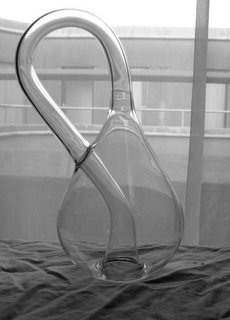 As soon as I saw the box from Meghan in the porter’s lodge, I knew that there was a closed, non-orientable, boundary-free manifold in Wadham. Despite my birthday not being for another four days, not opening it at that point would have been pointless and superfluous. After all, it is better to have a Klein Bottle on display than a Klein bottle which you know to be in a box. I trust that Meghan will understand.
As soon as I saw the box from Meghan in the porter’s lodge, I knew that there was a closed, non-orientable, boundary-free manifold in Wadham. Despite my birthday not being for another four days, not opening it at that point would have been pointless and superfluous. After all, it is better to have a Klein Bottle on display than a Klein bottle which you know to be in a box. I trust that Meghan will understand.
As you are like to find in the office of a particularly cool mathematician, it is a genuine Klein Bottle: such as you would get if you could glue the edges of two Mobius strips together. While that is not actually possible in three dimensional space, the Klein Bottle is a three-dimensional cross section of that higher dimensional object. Imagine, for a moment, a hair elastic twisted into a figure-eight shape. In three dimensions, you can do that without having it intersect itself. If you were to draw that figure-eight hair elastic, however, or take a photo, it would look as though it intersects itself. The same is true of a Klein Bottle embedded in three dimensional space. Note that even if our universe really does have ten spacial dimensions, or more, as postulated by string theory, there are still only three of them unfurled enough to put parts of a glass Klein Bottle in.
Invented by Felix Klein – a German professor of mathematics – in 1882, a Klein Bottle has only one side (no inside and outside like a balloon), yet also no rim or lip (like a bowl or an open wine bottle). It’s the only gift I’ve ever received that I printed off an encyclopedia article about, for use in explaining to guests. You can also tell people it’s a work of modern art.
Many thanks Meghan, for furnishing me with what may be the geekiest thing I have ever owned. Like surviving through a battle in which your friends died, getting a Klein Bottle creates a commitment to live the rest of your life in a certain spirit. It’s also dramatically quieter than my rock tumbler used to be.
